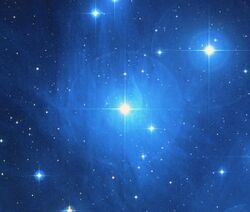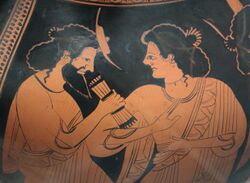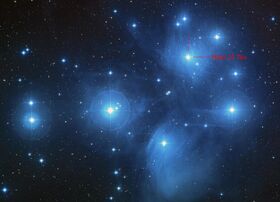Astronomy:Maia (star)
| Observation data Equinox J2000.0]] (ICRS) | |
|---|---|
| Constellation | Taurus |
| Pronunciation | /ˈmeɪə/[1] |
| Right ascension | 03h 45m 49.6066s[2] |
| Declination | 24° 22′ 03.886″[2] |
| Apparent magnitude (V) | 3.87[3] |
| Characteristics | |
| Spectral type | B8III[4] |
| U−B color index | −0.40[5] |
| B−V color index | −0.07[5] |
| Variable type | Suspected |
| Astrometry | |
| Radial velocity (Rv) | 7.40[6] km/s |
| Proper motion (μ) | RA: 20.95[2] mas/yr Dec.: −45.98[2] mas/yr |
| Parallax (π) | 8.51 ± 0.28[2] mas |
| Distance | 380 ± 10 ly (118 ± 4 pc) |
| Absolute magnitude (MV) | −1.54[7] |
| Details | |
| Mass | 3.77[8] M☉ |
| Radius | 3.59[8] R☉ |
| Luminosity | 501[8] L☉ |
| Surface gravity (log g) | 3.89[8] cgs |
| Temperature | 12,300[8] K |
| Metallicity [Fe/H] | 1.10[9] dex |
| Rotational velocity (v sin i) | 33[10] km/s |
| Age | 126[8] Myr |
| Other designations | |
| Database references | |
| SIMBAD | data |
Coordinates: ![]() 03h 45m 49.607s, +24° 22′ 03.895″
Maia /ˈmeɪə/, designated 20 Tauri (abbreviated 20 Tau), is a star in the constellation of Taurus. It is a blue giant of spectral type B8 III, a chemically peculiar star, and the prototype of the Maia variable class of variable star.
03h 45m 49.607s, +24° 22′ 03.895″
Maia /ˈmeɪə/, designated 20 Tauri (abbreviated 20 Tau), is a star in the constellation of Taurus. It is a blue giant of spectral type B8 III, a chemically peculiar star, and the prototype of the Maia variable class of variable star.
Maia is the fourth-brightest star in the Pleiades open star cluster (Messier 45), after Alcyone, Atlas and Electra. It is surrounded by one of the brighter reflection nebulae within the Pleiades, designated NGC 1432 and sometimes called the Maia Nebula.
Nomenclature
The name Maia originates with the Greek: Μαῖα and Latin: Maia. Maia is one of the seven daughters of Atlas and Pleione in Greek mythology—stars which are also included in the Pleiades star cluster. In 2016, the International Astronomical Union organized a Working Group on Star Names (WGSN)[11] to catalog and standardize proper names for stars. The WGSN's first bulletin of July 2016[12] included a table of the first two batches of names approved by the WGSN; which included Maia for this star. It is now so entered in the IAU Catalog of Star Names.[13]
20 Tauri is the star's Flamsteed designation. Although it is about the 15th brightest star in Taurus, Maia does not have a Bayer designation, but does have the Bright Star Catalogue designation HR 1149 and the Henry Draper Catalogue designation HD 23408.[14] It has been listed as double star WDS J03458+2422; one companion is a 14th magnitude star nearly 2′ away that is probably an unrelated background object. The primary is listed as being double following observations of a lunar occultation,[15] but later observations have failed to find any evidence of it being double.[16]
Description

The distance to Maia has been measured by the Gaia spacecraft using the annual parallax method. In Gaia Data Release 2, the parallax is given as 9.4789±0.6827 mas,[17] corresponding to a distance of 106+9
−7 pc. The 2007 new Hipparcos reduction gives a statistically more accurate parallax of 8.51±0.28 mas, indicating a distance of 118±4 pc.[2] Analysis of Gaia parallaxes for the whole Pleiades cluster give an average distance of 136.2±5.0 pc,[18] while VLBI measurements of multiple members give a distance of 136.2±1.2 pc.[19]
Maia's visual magnitude is 3.87, requiring darker skies to be seen. Its bolometric luminosity is 501 times solar, mostly in the ultraviolet, thus suggesting a radius that is 3.6 times that of the Sun and a mass that is 3.8 times solar.[8] Interferometric measurements give an angular diameter of 0.436±0.023 mas, suggesting a radius of 4.95 R☉ assuming a distance of 113.5 pc. These measurements also allow the effective temperature to be estimated at 14,700±900 K.[20]
Maia is a chemically peculiar star, meaning it has an unusual surface abundance of some elements as shown by its spectral lines. It is classified as a helium-weak star, but it also shows an excess of some elements including manganese.[21]

Maia was thought to be a variable star by astronomer Otto Struve. He proposed a class of stars known as Maia variables, which included Gamma Ursae Minoris. Examination of the Hipparcos data for Maia and some others in the class found no evidence of variability.[23] On the other hand, White et al. found low amplitude, but unambiguous, variability in Maia's brightness as seen by Kepler/K2, with a period of 10.3 days, which they attribute to the rotation of a starspot.[22] Intense study of large numbers of stars suggest that 6.7% of stars with temperatures between 10,000 K and 18,000 K show rapid small-amplitude pulsations but are not members of other variable star classes. These are potentially Maia variables.[24] Ironically, if the White et al. results are correct, Maia is a variable star, but not a Maia variable star.
Maia is surrounded by the Maia Nebula (also known as NGC 1432), a reflection nebula that is one of the brightest patches of nebulosity within the Pleiades star cluster.[25] It is the only member of the New General Catalogue discovered photographically.[26]
Mythology

Maia was the oldest of seven beautiful sisters known as the Pleiades. She was impregnated by Zeus, thereby conceiving Hermes, the messenger god. As Maia and the Pleiades are visible in the winter night sky along with the constellation Orion, the Greek myths tell of Maia and her sisters being pursued by the giant huntsman and turned into doves to preserve their safety.[27]
References
- ↑ Kunitzsch, Paul; Smart, Tim (2006). A Dictionary of Modern star Names: A Short Guide to 254 Star Names and Their Derivations (2nd rev. ed.). Cambridge, Massachusetts: Sky Pub. ISBN 978-1-931559-44-7.
- ↑ 2.0 2.1 2.2 2.3 2.4 2.5 Van Leeuwen, F. (2007). "Validation of the new Hipparcos reduction". Astronomy and Astrophysics 474 (2): 653–664. doi:10.1051/0004-6361:20078357. Bibcode: 2007A&A...474..653V.
- ↑ Ducati, J. R. (2002). "VizieR Online Data Catalog: Catalogue of Stellar Photometry in Johnson's 11-color system". CDS/ADC Collection of Electronic Catalogues 2237. Bibcode: 2002yCat.2237....0D.
- ↑ Grenier, S.; Baylac, M.-O.; Rolland, L.; Burnage, R.; Arenou, F.; Briot, D.; Delmas, F.; Duflot, M. et al. (1999). "Radial velocities. Measurements of 2800 B2-F5 stars for HIPPARCOS". Astronomy and Astrophysics Supplement 137 (3): 451. doi:10.1051/aas:1999489. Bibcode: 1999A&AS..137..451G.
- ↑ 5.0 5.1 Johnson, H. L.; Iriarte, B.; Mitchell, R. I.; Wisniewski, W. Z. (1966). "UBVRIJKL photometry of the bright stars". Communications of the Lunar and Planetary Laboratory 4: 99. Bibcode: 1966CoLPL...4...99J.
- ↑ Gontcharov, G. A. (November 2006). "Pulkovo Compilation of Radial Velocities for 35 495 Hipparcos stars in a common system". Astronomy Letters 32 (11): 759–771. doi:10.1134/S1063773706110065. Bibcode: 2006AstL...32..759G.
- ↑ Kochukhov, O.; Bagnulo, S. (2006). "Evolutionary state of magnetic chemically peculiar stars". Astronomy and Astrophysics 450 (2): 763. doi:10.1051/0004-6361:20054596. Bibcode: 2006A&A...450..763K.
- ↑ 8.0 8.1 8.2 8.3 8.4 8.5 8.6 Glagolevskij, Yu. V. (2019). "On Properties of Main Sequence Magnetic Stars". Astrophysical Bulletin 74 (1): 66. doi:10.1134/S1990341319010073. Bibcode: 2019AstBu..74...66G.
- ↑ Heacox, W. D. (1979). "Chemical abundances in Hg-Mn stars". Astrophysical Journal Supplement Series 41: 675–688. doi:10.1086/190637. Bibcode: 1979ApJS...41..675H.
- ↑ Royer, F.; Grenier, S.; Baylac, M.-O.; Gómez, A. E.; Zorec, J. (2002). "Rotational velocities of A-type stars in the northern hemisphere. II. Measurement of v sin i in the northern hemisphere". Astronomy and Astrophysics 393 (3): 897–911. doi:10.1051/0004-6361:20020943. Bibcode: 2002A&A...393..897R.
- ↑ "IAU Working Group on Star Names (WGSN)". https://www.iau.org/science/scientific_bodies/working_groups/280/.
- ↑ "Bulletin of the IAU Working Group on Star Names, No. 1". http://www.pas.rochester.edu/~emamajek/WGSN/WGSN_bulletin1.pdf.
- ↑ "IAU Catalog of Star Names". http://www.pas.rochester.edu/~emamajek/WGSN/IAU-CSN.txt.
- ↑ "HD-DM-GC-HR-HIP-Bayer-Flamsteed Cross Index". Institute of Astronomy of Russian Academy of Sciences. 2002. http://cdsarc.u-strasbg.fr/viz-bin/Cat?cat=IV%2F27A&target=readme.
- ↑ Mason, Brian D.; Wycoff, Gary L.; Hartkopf, William I.; Douglass, Geoffrey G.; Worley, Charles E. (2001). "The 2001 US Naval Observatory Double Star CD-ROM. I. The Washington Double Star Catalog". The Astronomical Journal 122 (6): 3466. doi:10.1086/323920. Bibcode: 2001AJ....122.3466M.
- ↑ Hoffleit, Dorrit; Jaschek, Carlos (1991). "The Bright star catalogue". New Haven. Bibcode: 1991bsc..book.....H.
- ↑ Brown, A. G. A. (August 2018). "Gaia Data Release 2: Summary of the contents and survey properties". Astronomy & Astrophysics 616: A1. doi:10.1051/0004-6361/201833051. Bibcode: 2018A&A...616A...1G. Gaia DR2 record for this source at VizieR.
- ↑ Abramson, Guillermo (20 August 2018). "The Distance to the Pleiades According to Gaia DR2". Research Notes of the AAS 2 (3): 150. doi:10.3847/2515-5172/aada8b. Bibcode: 2018RNAAS...2..150A.
- ↑ Melis, Carl; Reid, Mark J.; Mioduszewski, Amy J.; Stauffer, John R. et al. (29 August 2014). "A VLBI resolution of the Pleiades distance controversy". Science 345 (6200): 1029–1032. doi:10.1126/science.1256101. PMID 25170147. Bibcode: 2014Sci...345.1029M.
- ↑ Gordon, Kathryn D.; Gies, Douglas R.; Schaefer, Gail H.; Huber, Daniel; Ireland, Michael (2019). "Angular Sizes, Radii, and Effective Temperatures of B-type Stars from Optical Interferometry with the CHARA Array". The Astrophysical Journal 873 (1): 91. doi:10.3847/1538-4357/ab04b2. Bibcode: 2019ApJ...873...91G.
- ↑ Renson, P.; Manfroid, J. (May 2009). "Catalogue of Ap, HgMn and Am stars". Astronomy and Astrophysics 498 (3): 961–966. doi:10.1051/0004-6361/200810788. Bibcode: 2009A&A...498..961R.
- ↑ 22.0 22.1 White, T. R. (November 2017). "Beyond the Kepler/K2 bright limit: variability in the seven brightest members of the Pleiades". Monthly Notices of the Royal Astronomical Society 471 (3): 2882–2901. doi:10.1093/mnras/stx1050. Bibcode: 2017MNRAS.471.2882W. https://academic.oup.com/mnras/article/471/3/2882/4081952. Retrieved 7 October 2022.
- ↑ Percy, John R.; Wilson, Joseph B. (2000). "Another Search for Maia Variable Stars". Publications of the Astronomical Society of the Pacific 112 (772): 846. doi:10.1086/316577. Bibcode: 2000PASP..112..846P.
- ↑ Balona, L. A.; Ozuyar, D. (2020). "Pulsation among TESS a and B stars and the Maia variables". Monthly Notices of the Royal Astronomical Society 493 (4): 5871. doi:10.1093/mnras/staa670. Bibcode: 2020MNRAS.493.5871B.
- ↑ "SEDS Students for the Exploration and Development of Space". NGC 1432. http://seds.org/~spider/ngc/ngc.cgi?1432.
- ↑ Steinicke, Wolfgang (2010). Observing and Cataloguing Nebulae and Star Clusters: From Herschel to Dreyer's New General Catalogue. Cambridge University Press. p. 8. ISBN 9781316644188.
- ↑ Hesiod, Works and Days 619ff.
External links
- Jim Kaler's Stars, University of Illinois:Maia (20 Tauri)
- High-resolution LRGB image based on 4 hrs total exposure: NGC 1432 - Maia Nebula
- APOD Pictures:
 |


